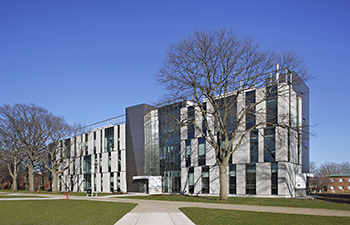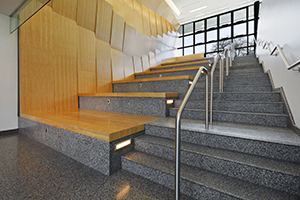SUNY’s Farmingdale State College Debuts Business School
 FARMINGDALE, N.Y. — Farmingdale State College recently debuted a new $26.7 million School of Business building, which will serve 2,200 students and 40 professors of the growing undergraduate business program.
FARMINGDALE, N.Y. — Farmingdale State College recently debuted a new $26.7 million School of Business building, which will serve 2,200 students and 40 professors of the growing undergraduate business program.
Farmingdale State College is part of the State University of New York (SUNY) system, and construction on its new business school broke ground in the fall of 2012. Stalco Construction Inc. served as the general contractor; Urbahn Architects served as the architect; and Jacobs Engineering Group served as the construction manager on the new educational facility project. All three companies have offices in New York.
“Part of a $185 million multisite construction project, this is the most technologically advanced building on campus,” said Farmingdale State College President Dr. W. Hubert Keen.
The new School of Business, which is aiming for LEED Silver certification, features a modern façade, expansive glass curtain wall and a high number of environmentally responsible design and engineering solutions, according to Stalco Construction Principal Kevin Harney. The school’s energy efficiency performance exceeds New York State’s requirements by 30 percent.
The building is designed as a three-story, rectangular ‘bar’ with program spaces on either side of an efficient, double-loaded corridor, explained Peter Verne, AIA, LEED AP, senior associate for Urbahn Architects and the project’s lead designer. Faculty offices and lounges primarily make up the west side of the corridor, while classroom spaces are located to the east.
“We designed the lobby to serve both as an event reception space as well as a place for students to relax between classes,” Verne said. “It features faceted bamboo seating and a stainless-steel cantilevered stair projecting into the glazed triple-height atrium.”
The design team developed multiple types of lounges, from contemplative spaces located off the main path of travel to active spaces adjacent to the main corridor — wired so students can plug in devices for group display, he added. The freestanding elevator shaft directs the eye upward within the atrium lobby and acts as a signpost announcing the main entrance. Plus, the classrooms feature face-to-face tiered seating to foster professor-led discussion and debate among students.
 Many of the project’s challenges were related to the building’s infrastructure and MEP systems as well as construction logistics, according to Stalco Senior Project Manager Kevin Sypher. The building has its own cooling tower, situated adjacent to the main structure, which makes its own chilled water for cooling, and the crews had to build new steam piping and connections to the campus steam plant. The interiors also feature many unusual and innovative materials such as sustainable bamboo cladding, an exposed steel architectural staircase, electric shades and a smoke purge system with windows and doors that automatically open when the smoke purge fans activate.
Many of the project’s challenges were related to the building’s infrastructure and MEP systems as well as construction logistics, according to Stalco Senior Project Manager Kevin Sypher. The building has its own cooling tower, situated adjacent to the main structure, which makes its own chilled water for cooling, and the crews had to build new steam piping and connections to the campus steam plant. The interiors also feature many unusual and innovative materials such as sustainable bamboo cladding, an exposed steel architectural staircase, electric shades and a smoke purge system with windows and doors that automatically open when the smoke purge fans activate.
“The Stalco team employed several technological and material solutions that allowed the crews to accelerate the construction schedule,” said Stalco Assistant Project Manager Kimberly Klein Chappina. “For example, Stalco utilized the National Gypsum mold and moisture gypsum wall panels and compound rather than regular gypsum boards. This allowed the interior work to continue through winter months inside a structure that was still open to the elements, while the complex glass and rain screen building enclosure was still being installed.”
In the early pre-design phase, Urbahn performed an extensive analysis of the business school’s and the entire college’s spatial needs, patterns and frequency of space use, enrollment forecasts, overall campus master plan, traffic patterns and architectural history. The architects collaborated extensively with the college’s leadership, physical plant management, Dean of the School of Business and faculty in order to define the school’s philosophy and technological needs.
This analysis, as well as the available budget, guided the architects during the development of the new school’s architecture, interior programming, design approach and engineering. It also helped in the selection of the location for the new structure. Following a site selection analysis of several alternative locations for the new School of Business by reviewing their impact on the pedestrian traffic flow, vehicular access, utilities availability and distance, and compatibility with the overall campus development plan, the architects and college leadership selected a site previously occupied by a dorm that had been demolished several years ago. This solution not only restored the completeness of the overall quad plan, but also provided LEED credits in the sustainable site category.
“Late twentieth-century development had shifted activity away from the original campus core,” Verne said. “The siting of the new building and the views from within are designed to reinforce and reenergize the historic campus center.”
During the design phase, the architects also strived to reflect the historic architecture of the campus in the new school. The building’s façade features a modern interpretation of the traditional elements, materials and colors. The exterior materials of brick, glass-fiber-reinforced concrete panels (GFRC), composite metal panels and glass relate in texture and color to the brick, cast stone and slate traditionally employed on the core campus buildings. The use of this familiar palette also helps define sections enclosing individual program areas.
The Dean of the School of Business helped the design team throughout the process, challenging the team to create a building that would foster learning both inside and outside the classroom, according to Verne. “More than simply providing a new building, this project afforded an opportunity to return clarity and definition to the surrounding outdoor quad spaces,” he said.
In addition to Stalco Construction Inc., Jacobs Engineering Group and Urbahn Architects, the project team consisted of structural engineer Consulting Engineers Collaborative, based in Kenilworth, N.J.; civil engineer BET Engineering Consultants, based in Hanover, N.J.; mechanical, electrical and plumbing (MEP) engineer Vanderweil Engineers, headquartered in Boston; lighting designer Domingo Gonzalez Associates, based in New York; and landscape architect Starr Whitehouse Landscape Architects, also based in New York.
